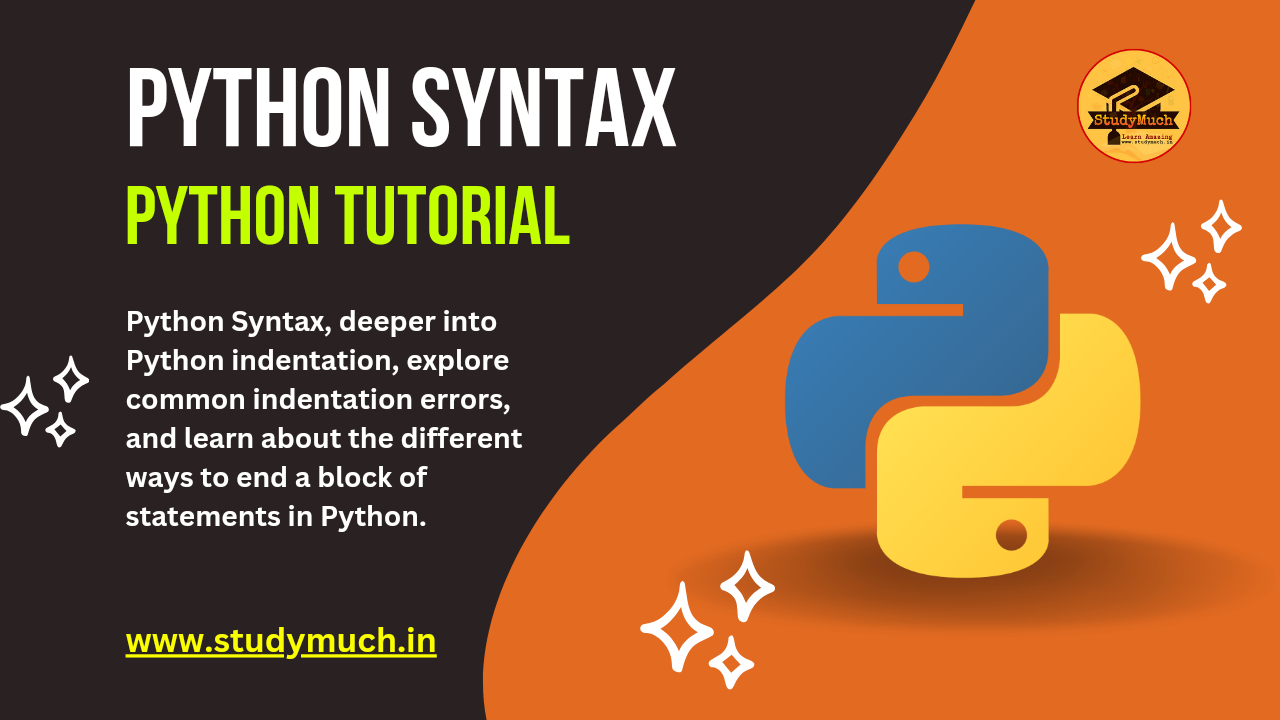Python Syntax

Python Syntax; Indentation errors, and final blocks of statements
Python is famous for its simple and elegant syntax, which makes it one of the most beginner-friendly programming languages. A key aspect of Python’s syntax is its reliance on indentation to indicate blocks of code. In this blog post, we’ll delve about Python Syntax, deeper into Python indentation, explore common indentation errors, and learn about the different ways to end a block of statements in Python.
What is Python Syntax?
Syntax is the set of rules and guidelines followed when writing Python program. It defines the proper format for expressing instructions, statements, and expressions in the Python programming language. Syntax serves as the foundation for writing valid and functional.
Key aspects of Python syntax include:
- Indentation: Python uses indentation (spaces or tabs) to define blocks of code. Indentation is critical for indicating the scope of loops, functions, conditional statements, and other code structures. Proper and consistent indentation is essential for code readability and correctness.
- Statements: In Python, a statement is a single line of code that performs a specific action or operation. Examples of statements include variable assignments, function calls, loops, and conditional statements. Statements are typically terminated by a newline character, but they can be continued across multiple lines using line continuation characters.
- Comments: Comments are used to provide explanations or notes within the code for developers and readers. In Python, comments start with the # character and continue until the end of the line. Comments are ignored by the Python interpreter and do not affect the program’s functionality.
- Variables and Data Types: Variables in Python are used to store data and are declared using a variable name followed by an assignment operator (=). Python is dynamically typed, meaning the data type of a variable is determined at runtime based on the value assigned to it. Python supports various data types, such as integers, floats, strings, lists, dictionaries, and more.
- Conditional Statements: Conditional statements, like if, elif, and else, are used to make decisions in the code based on certain conditions. The syntax of these statements requires the use of colons (:) to signify the start of a code block associated with a particular condition.
- Loops: Python provides for and while loops to repeat a block of code multiple times. Similar to conditional statements, loops require colons (:) to indicate the start of the code block that should be executed repeatedly.
- Functions: Functions are blocks of code that can be defined once and called multiple times to perform a specific task. Python functions are defined using the def keyword, followed by the function name and parentheses.
Python’s syntax emphasizes readability and clarity, making the language popular among beginners and experienced developers alike.

1. Python Indentation:
Indentation in Python is very important, many programming languages, which use braces or keywords to define blocks of code, Python uses indentation to represent a hierarchy of statements. Proper indentation is essential to making Python code both readable and functional. Indentation serves as a visual clue to identify the beginning and end of loops, functions, conditional statements, and more. Consistency in indentation is important to avoid errors and maintain code readability.
Example of proper python indentation:
def greet(name): if name == 'Alice': print('Hello, Alice!') else: print('Hello, stranger!')
In the above example, the indentation inside the function greet signifies that the if-else
statement is within the function’s block. The print statements are further indented to indicate their association with the if-else block.
2. Indentation Errors:
Indentation errors are one of the most common pitfalls for Python beginners. These errors occur when indentation is inconsistent or incorrect, leading to unexpected behavior or syntax errors in the code. Python is sensitive to the number of spaces or tabs used for indentation, so it is essential to be mindful of this while writing code.
Example of Indentation Error:
def my_function(): print('Hello, World!') print('Welcome to Python Syntax Guide!') print('Indentation Error: Inconsistent indentation')
In the above code, the third print statement is indented using an extra space compared to the previous lines, causing an indentation error.

3. Ending a Block of Statements:
In Python, the end of a block of statements is indicated by dedenting, i.e., reducing the level of indentation to the previous level. Dedenting signifies the conclusion of loops, functions, conditional statements, and other indented blocks. Python relies on dedenting to determine when a particular block of code ends, which makes it crucial to maintain correct indentation levels.
Example of Ending a Block of Statements:
for i in range(5): print('Current value of i:', i) print('Loop has ended. This statement is not part of the loop.')
In the above code, the print statement after the for loop is not indented, indicating that it is not part of the loop block.
4. Code Blocks and Colons:
In Python, certain constructs like loops and conditional statements require a colon (:) after the statement, followed by an indented block. The colon serves as a visual marker that a code block is starting.
Example of Code Blocks and Colons:
if x > 10: print('x is greater than 10') else: print('x is not greater than 10')
In the above code, the if and else statements are followed by colons, indicating that they have associated blocks of code. The indented lines below each if and else are the respective code blocks.
5. Indentation Best Practices:
To ensure clean and error-free Python code, consider the following best practices:
- Use consistent indentation with either spaces or tabs (recommended: four spaces for each level of indentation).
- Avoid mixing spaces and tabs for indentation, as this may lead to syntax errors.
- Follow Python’s PEP 8 style guide, which recommends using spaces for indentation.
- Use an IDE or text editor that automatically handles indentation to reduce human error.
Conclusion:
Python’s use of indentation is a unique and powerful feature that contributes to its readability and maintainability. By understanding the importance of proper indentation, avoiding indentation errors, and appropriately ending blocks of statements, you can write clean and effective Python code. Remember to adhere to the recommended best practices, and your Python coding journey will become even more enjoyable and productive! Happy coding!
Learn More;



0 Comments